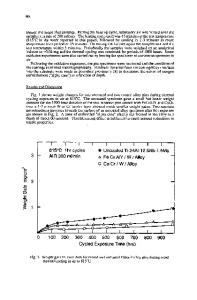Characterization and properties of intermetallic Al 3 Ti alloy synthesized by reactive foil sintering in vacuum
- PDF / 311,202 Bytes
- 8 Pages / 584.957 x 782.986 pts Page_size
- 71 Downloads / 347 Views
Xiaoxiao Han and Xueyi Zhang College of Aerospace and Civil Engineering, Harbin Engineering University, Harbin 150001, China
Yang Cao Mechanical and Electrical Engineering Institute, Zhengzhou University of Light Industry, Zhengzhou 450002, China
Chunhuan Guo, Zichuan Lu, and Fengchun Jianga) Key Laboratory of Superlight Materials & Surface Technology, Ministry of Education, Harbin Engineering University, Harbin 150001, China (Received 17 February 2016; accepted 25 July 2016)
A dense monolithic intermetallic Al3Ti alloy was successfully synthesized via reactive sintering in vacuum using TC4 alloy and pure aluminum foils with appropriate initial thickness. Energy dispersive spectroscopy (EDS), x-ray diffractometry (XRD), and scanning electron microscopy (SEM) were used to characterize the phase and microstructure of Al3Ti alloy. Ultrasonic measurement was performed to evaluate the physical property of Al3Ti alloy. Different thermal analysis, thermogravimetry (TG) and differential scanning calorimetry (DSC) were used to assess the thermal property of Al3Ti alloy. The compressive tests were carried out on a universal load frame to determine the mechanical properties, including the compressive strength and failure strain of the fabricated intermetallic Al3Ti alloy. The current results indicated that the density of Al3Ti alloy is slightly higher than the theoretical density, the average Young’s modulus is lower than the theoretical value. A trace of aluminum in Al3Ti alloy was detected, which is distinctly affected on the density, Young’s modulus and mechanical properties of this titanium aluminide alloy. The stress–strain curves of Al3Ti alloy shows a linear elastic behavior without any plastic deformation, and the fracture features are the mixed fracture of transgranular and intergranular. Some other fundamental physical and mechanical properties of the Al3Ti alloy were also obtained in the present study.
I. INTRODUCTION
In recent years, new materials with improved combination of physical, mechanical, and chemical properties have increasing demand for lightweight components in automotive and aerospace applications. Ti–Al alloys are the most attractive candidate materials used under elevated temperatures owing to their low density, superior elevated temperature strength, oxidation, and corrosion resistance.1,2 Compared with other homologous intermetallic alloys, such as Ti3Al and TiAl alloys, Al3Ti possesses the lowest density, ;3.36 g/cm3, due to its greater aluminum content, highest Young’s modulus, ;216 GPa,3 and highest oxidation resistance resulting from the formation of an impervious Al2O3 layer during its exposition to air.4–6 The Al3Ti alloy therefore has Contributing Editor: Jürgen Eckert a) Address all correspondence to this author. e-mail: [email protected] DOI: 10.1557/jmr.2016.298
a great potential application in aerospace and automobile as a high-temperature structural material. It is well known that intermetallic Al3Ti alloy has the poorest ductility among these three typical titanium alum
Data Loading...











